Performance Management and HR Analytics Report: MGMT 9032
VerifiedAdded on 2022/09/15
|9
|2167
|18
Report
AI Summary
This report analyzes a case study on performance management, specifically addressing Mr. Mehta's dilemma within the organization AXZ. The report begins by examining the shortcomings of the existing performance appraisal process, highlighting communication gaps, lack of clarity, and the limitations of the forced bell curve model. It then proposes alternative methods, such as a 360-degree feedback system and clear, measurable performance standards, to improve the process and reduce employee dissatisfaction. Furthermore, the report delves into a literature review exploring the impact of technology on performance management, emphasizing the role of HR analytics in providing insights into workforce planning, employee performance, development, compensation, and retention. The report concludes by outlining five key HR metrics for measuring and gaining insights into business performance.
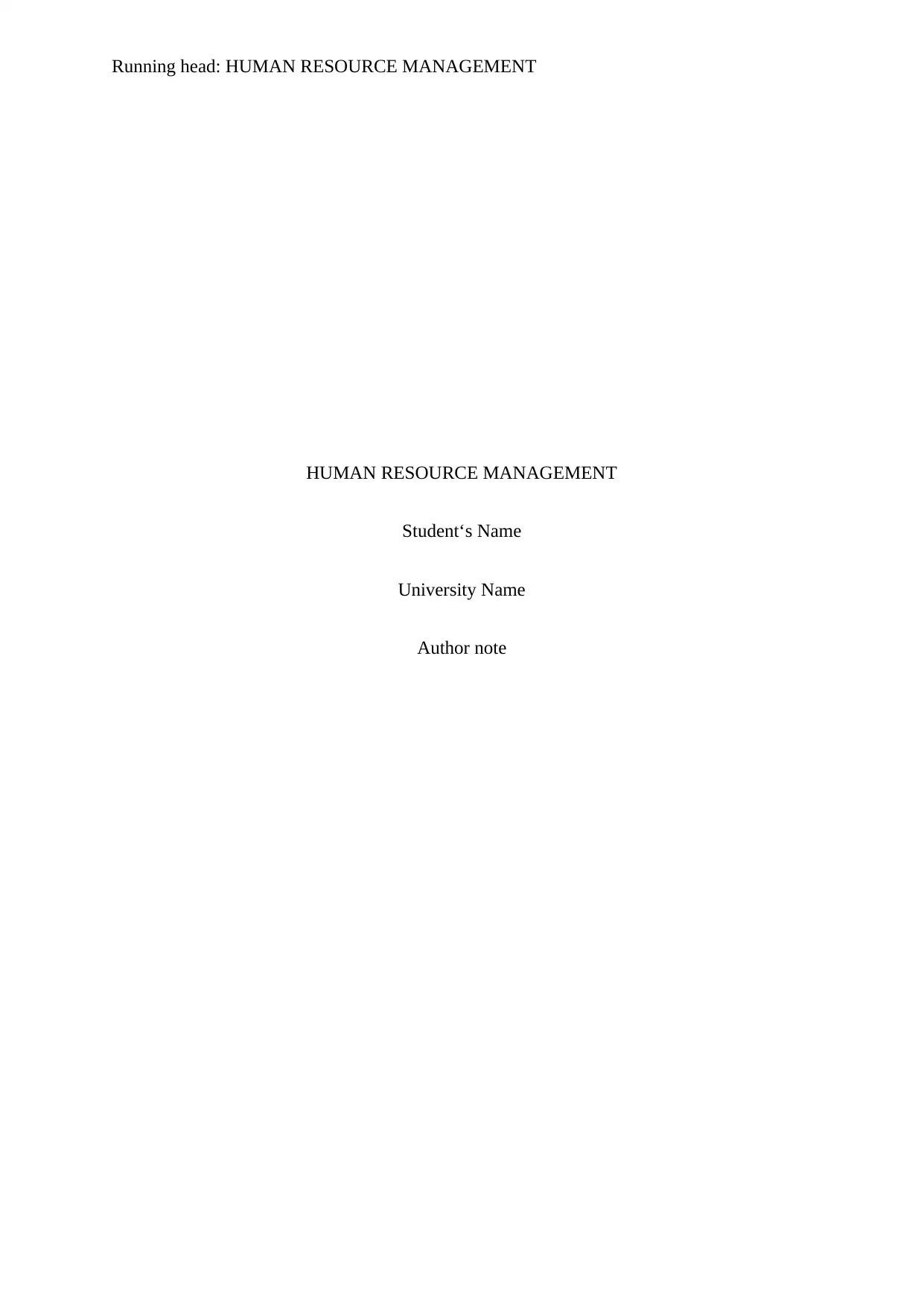
Running head: HUMAN RESOURCE MANAGEMENT
HUMAN RESOURCE MANAGEMENT
Student‘s Name
University Name
Author note
HUMAN RESOURCE MANAGEMENT
Student‘s Name
University Name
Author note
Paraphrase This Document
Need a fresh take? Get an instant paraphrase of this document with our AI Paraphraser
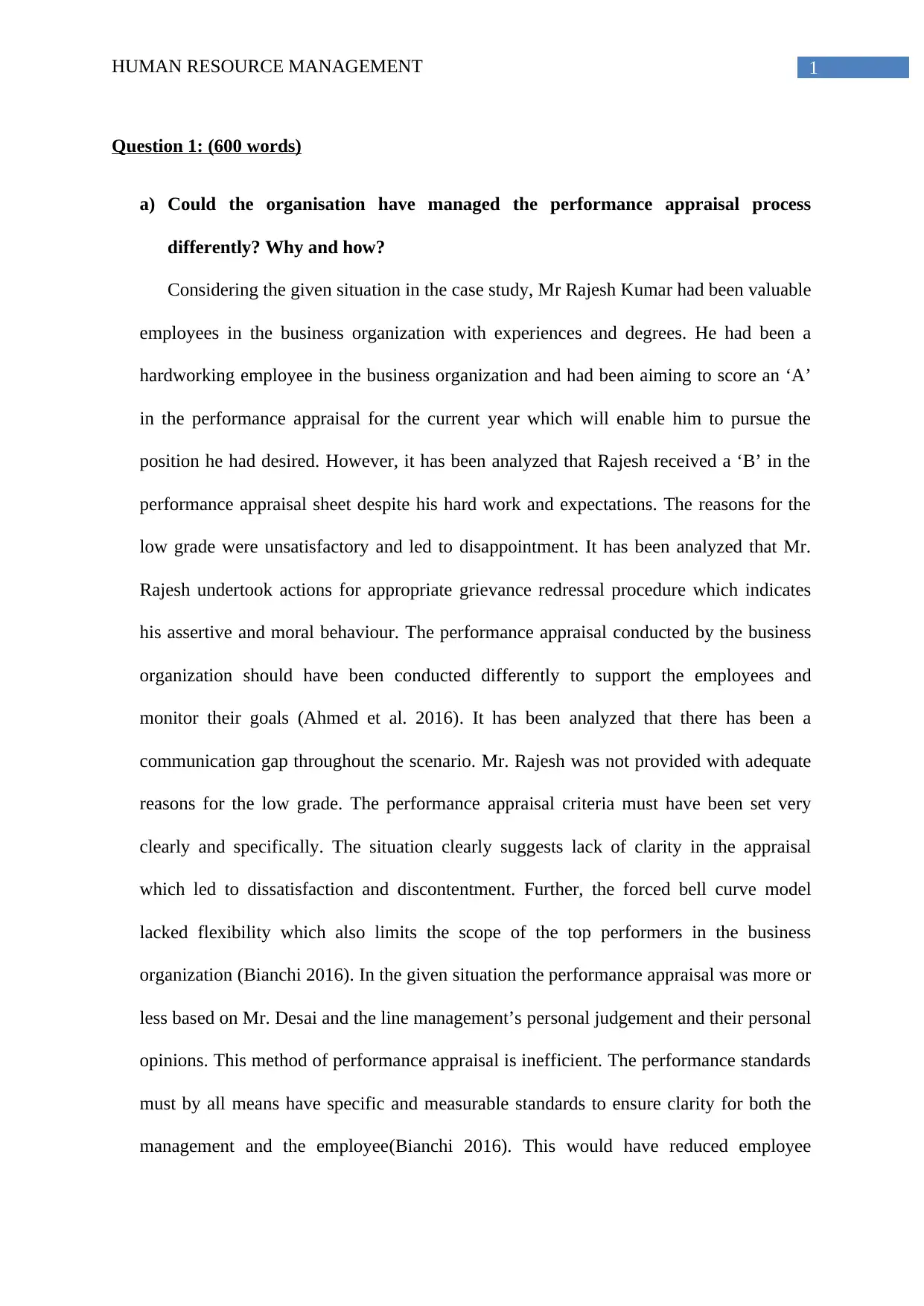
1HUMAN RESOURCE MANAGEMENT
Question 1: (600 words)
a) Could the organisation have managed the performance appraisal process
differently? Why and how?
Considering the given situation in the case study, Mr Rajesh Kumar had been valuable
employees in the business organization with experiences and degrees. He had been a
hardworking employee in the business organization and had been aiming to score an ‘A’
in the performance appraisal for the current year which will enable him to pursue the
position he had desired. However, it has been analyzed that Rajesh received a ‘B’ in the
performance appraisal sheet despite his hard work and expectations. The reasons for the
low grade were unsatisfactory and led to disappointment. It has been analyzed that Mr.
Rajesh undertook actions for appropriate grievance redressal procedure which indicates
his assertive and moral behaviour. The performance appraisal conducted by the business
organization should have been conducted differently to support the employees and
monitor their goals (Ahmed et al. 2016). It has been analyzed that there has been a
communication gap throughout the scenario. Mr. Rajesh was not provided with adequate
reasons for the low grade. The performance appraisal criteria must have been set very
clearly and specifically. The situation clearly suggests lack of clarity in the appraisal
which led to dissatisfaction and discontentment. Further, the forced bell curve model
lacked flexibility which also limits the scope of the top performers in the business
organization (Bianchi 2016). In the given situation the performance appraisal was more or
less based on Mr. Desai and the line management’s personal judgement and their personal
opinions. This method of performance appraisal is inefficient. The performance standards
must by all means have specific and measurable standards to ensure clarity for both the
management and the employee(Bianchi 2016). This would have reduced employee
Question 1: (600 words)
a) Could the organisation have managed the performance appraisal process
differently? Why and how?
Considering the given situation in the case study, Mr Rajesh Kumar had been valuable
employees in the business organization with experiences and degrees. He had been a
hardworking employee in the business organization and had been aiming to score an ‘A’
in the performance appraisal for the current year which will enable him to pursue the
position he had desired. However, it has been analyzed that Rajesh received a ‘B’ in the
performance appraisal sheet despite his hard work and expectations. The reasons for the
low grade were unsatisfactory and led to disappointment. It has been analyzed that Mr.
Rajesh undertook actions for appropriate grievance redressal procedure which indicates
his assertive and moral behaviour. The performance appraisal conducted by the business
organization should have been conducted differently to support the employees and
monitor their goals (Ahmed et al. 2016). It has been analyzed that there has been a
communication gap throughout the scenario. Mr. Rajesh was not provided with adequate
reasons for the low grade. The performance appraisal criteria must have been set very
clearly and specifically. The situation clearly suggests lack of clarity in the appraisal
which led to dissatisfaction and discontentment. Further, the forced bell curve model
lacked flexibility which also limits the scope of the top performers in the business
organization (Bianchi 2016). In the given situation the performance appraisal was more or
less based on Mr. Desai and the line management’s personal judgement and their personal
opinions. This method of performance appraisal is inefficient. The performance standards
must by all means have specific and measurable standards to ensure clarity for both the
management and the employee(Bianchi 2016). This would have reduced employee
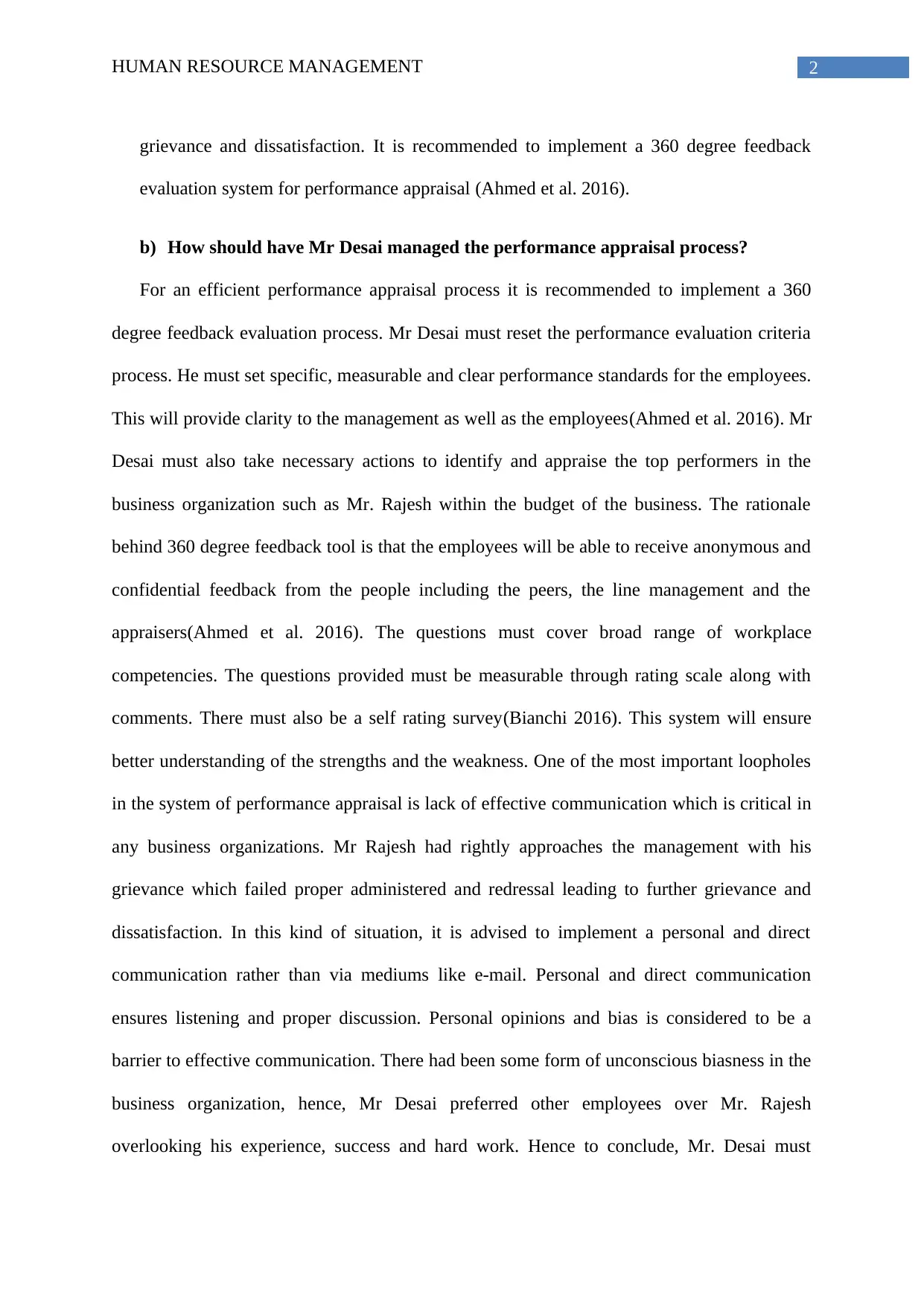
2HUMAN RESOURCE MANAGEMENT
grievance and dissatisfaction. It is recommended to implement a 360 degree feedback
evaluation system for performance appraisal (Ahmed et al. 2016).
b) How should have Mr Desai managed the performance appraisal process?
For an efficient performance appraisal process it is recommended to implement a 360
degree feedback evaluation process. Mr Desai must reset the performance evaluation criteria
process. He must set specific, measurable and clear performance standards for the employees.
This will provide clarity to the management as well as the employees(Ahmed et al. 2016). Mr
Desai must also take necessary actions to identify and appraise the top performers in the
business organization such as Mr. Rajesh within the budget of the business. The rationale
behind 360 degree feedback tool is that the employees will be able to receive anonymous and
confidential feedback from the people including the peers, the line management and the
appraisers(Ahmed et al. 2016). The questions must cover broad range of workplace
competencies. The questions provided must be measurable through rating scale along with
comments. There must also be a self rating survey(Bianchi 2016). This system will ensure
better understanding of the strengths and the weakness. One of the most important loopholes
in the system of performance appraisal is lack of effective communication which is critical in
any business organizations. Mr Rajesh had rightly approaches the management with his
grievance which failed proper administered and redressal leading to further grievance and
dissatisfaction. In this kind of situation, it is advised to implement a personal and direct
communication rather than via mediums like e-mail. Personal and direct communication
ensures listening and proper discussion. Personal opinions and bias is considered to be a
barrier to effective communication. There had been some form of unconscious biasness in the
business organization, hence, Mr Desai preferred other employees over Mr. Rajesh
overlooking his experience, success and hard work. Hence to conclude, Mr. Desai must
grievance and dissatisfaction. It is recommended to implement a 360 degree feedback
evaluation system for performance appraisal (Ahmed et al. 2016).
b) How should have Mr Desai managed the performance appraisal process?
For an efficient performance appraisal process it is recommended to implement a 360
degree feedback evaluation process. Mr Desai must reset the performance evaluation criteria
process. He must set specific, measurable and clear performance standards for the employees.
This will provide clarity to the management as well as the employees(Ahmed et al. 2016). Mr
Desai must also take necessary actions to identify and appraise the top performers in the
business organization such as Mr. Rajesh within the budget of the business. The rationale
behind 360 degree feedback tool is that the employees will be able to receive anonymous and
confidential feedback from the people including the peers, the line management and the
appraisers(Ahmed et al. 2016). The questions must cover broad range of workplace
competencies. The questions provided must be measurable through rating scale along with
comments. There must also be a self rating survey(Bianchi 2016). This system will ensure
better understanding of the strengths and the weakness. One of the most important loopholes
in the system of performance appraisal is lack of effective communication which is critical in
any business organizations. Mr Rajesh had rightly approaches the management with his
grievance which failed proper administered and redressal leading to further grievance and
dissatisfaction. In this kind of situation, it is advised to implement a personal and direct
communication rather than via mediums like e-mail. Personal and direct communication
ensures listening and proper discussion. Personal opinions and bias is considered to be a
barrier to effective communication. There had been some form of unconscious biasness in the
business organization, hence, Mr Desai preferred other employees over Mr. Rajesh
overlooking his experience, success and hard work. Hence to conclude, Mr. Desai must
⊘ This is a preview!⊘
Do you want full access?
Subscribe today to unlock all pages.

Trusted by 1+ million students worldwide
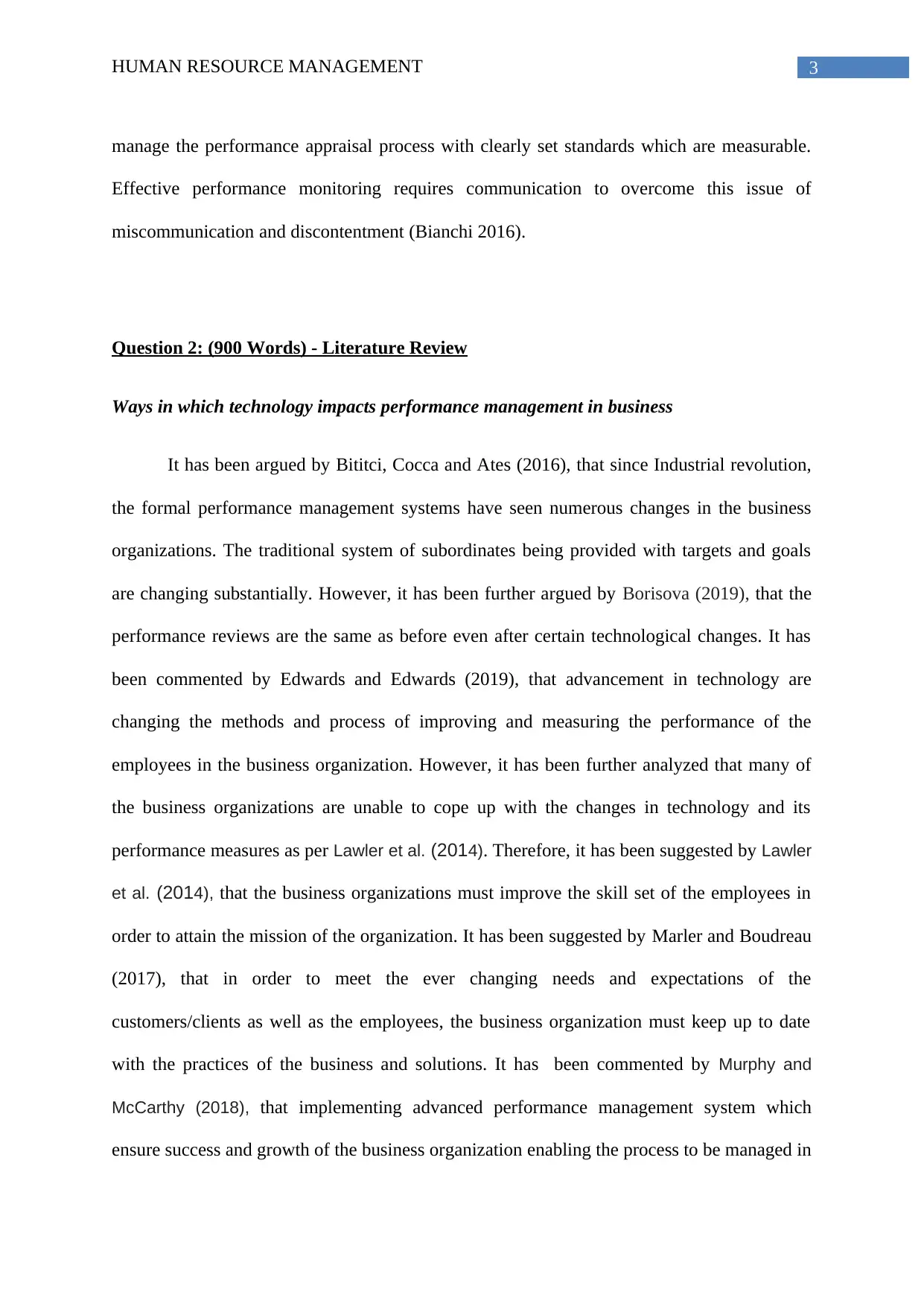
3HUMAN RESOURCE MANAGEMENT
manage the performance appraisal process with clearly set standards which are measurable.
Effective performance monitoring requires communication to overcome this issue of
miscommunication and discontentment (Bianchi 2016).
Question 2: (900 Words) - Literature Review
Ways in which technology impacts performance management in business
It has been argued by Bititci, Cocca and Ates (2016), that since Industrial revolution,
the formal performance management systems have seen numerous changes in the business
organizations. The traditional system of subordinates being provided with targets and goals
are changing substantially. However, it has been further argued by Borisova (2019), that the
performance reviews are the same as before even after certain technological changes. It has
been commented by Edwards and Edwards (2019), that advancement in technology are
changing the methods and process of improving and measuring the performance of the
employees in the business organization. However, it has been further analyzed that many of
the business organizations are unable to cope up with the changes in technology and its
performance measures as per Lawler et al. (2014). Therefore, it has been suggested by Lawler
et al. (2014), that the business organizations must improve the skill set of the employees in
order to attain the mission of the organization. It has been suggested by Marler and Boudreau
(2017), that in order to meet the ever changing needs and expectations of the
customers/clients as well as the employees, the business organization must keep up to date
with the practices of the business and solutions. It has been commented by Murphy and
McCarthy (2018), that implementing advanced performance management system which
ensure success and growth of the business organization enabling the process to be managed in
manage the performance appraisal process with clearly set standards which are measurable.
Effective performance monitoring requires communication to overcome this issue of
miscommunication and discontentment (Bianchi 2016).
Question 2: (900 Words) - Literature Review
Ways in which technology impacts performance management in business
It has been argued by Bititci, Cocca and Ates (2016), that since Industrial revolution,
the formal performance management systems have seen numerous changes in the business
organizations. The traditional system of subordinates being provided with targets and goals
are changing substantially. However, it has been further argued by Borisova (2019), that the
performance reviews are the same as before even after certain technological changes. It has
been commented by Edwards and Edwards (2019), that advancement in technology are
changing the methods and process of improving and measuring the performance of the
employees in the business organization. However, it has been further analyzed that many of
the business organizations are unable to cope up with the changes in technology and its
performance measures as per Lawler et al. (2014). Therefore, it has been suggested by Lawler
et al. (2014), that the business organizations must improve the skill set of the employees in
order to attain the mission of the organization. It has been suggested by Marler and Boudreau
(2017), that in order to meet the ever changing needs and expectations of the
customers/clients as well as the employees, the business organization must keep up to date
with the practices of the business and solutions. It has been commented by Murphy and
McCarthy (2018), that implementing advanced performance management system which
ensure success and growth of the business organization enabling the process to be managed in
Paraphrase This Document
Need a fresh take? Get an instant paraphrase of this document with our AI Paraphraser
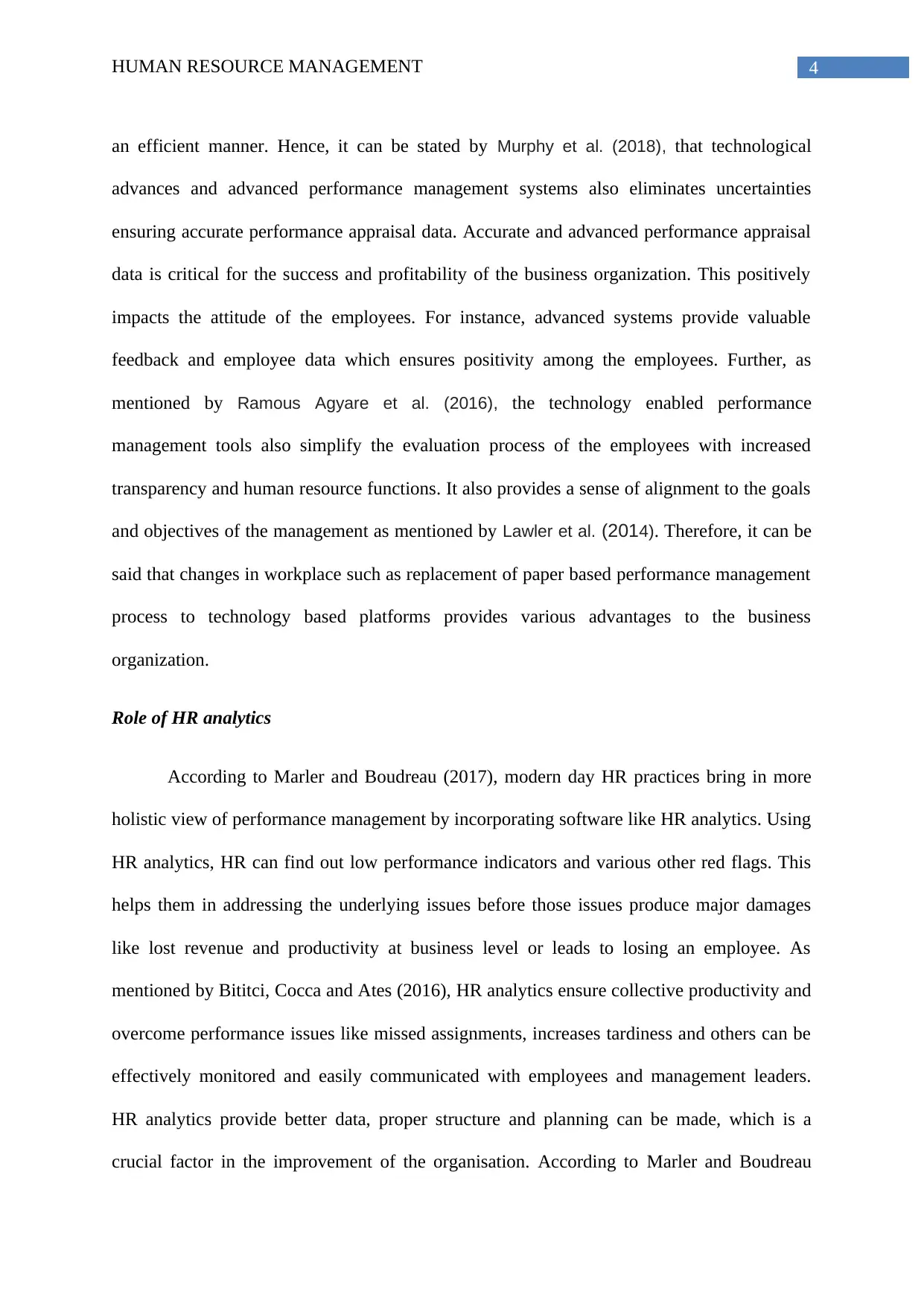
4HUMAN RESOURCE MANAGEMENT
an efficient manner. Hence, it can be stated by Murphy et al. (2018), that technological
advances and advanced performance management systems also eliminates uncertainties
ensuring accurate performance appraisal data. Accurate and advanced performance appraisal
data is critical for the success and profitability of the business organization. This positively
impacts the attitude of the employees. For instance, advanced systems provide valuable
feedback and employee data which ensures positivity among the employees. Further, as
mentioned by Ramous Agyare et al. (2016), the technology enabled performance
management tools also simplify the evaluation process of the employees with increased
transparency and human resource functions. It also provides a sense of alignment to the goals
and objectives of the management as mentioned by Lawler et al. (2014). Therefore, it can be
said that changes in workplace such as replacement of paper based performance management
process to technology based platforms provides various advantages to the business
organization.
Role of HR analytics
According to Marler and Boudreau (2017), modern day HR practices bring in more
holistic view of performance management by incorporating software like HR analytics. Using
HR analytics, HR can find out low performance indicators and various other red flags. This
helps them in addressing the underlying issues before those issues produce major damages
like lost revenue and productivity at business level or leads to losing an employee. As
mentioned by Bititci, Cocca and Ates (2016), HR analytics ensure collective productivity and
overcome performance issues like missed assignments, increases tardiness and others can be
effectively monitored and easily communicated with employees and management leaders.
HR analytics provide better data, proper structure and planning can be made, which is a
crucial factor in the improvement of the organisation. According to Marler and Boudreau
an efficient manner. Hence, it can be stated by Murphy et al. (2018), that technological
advances and advanced performance management systems also eliminates uncertainties
ensuring accurate performance appraisal data. Accurate and advanced performance appraisal
data is critical for the success and profitability of the business organization. This positively
impacts the attitude of the employees. For instance, advanced systems provide valuable
feedback and employee data which ensures positivity among the employees. Further, as
mentioned by Ramous Agyare et al. (2016), the technology enabled performance
management tools also simplify the evaluation process of the employees with increased
transparency and human resource functions. It also provides a sense of alignment to the goals
and objectives of the management as mentioned by Lawler et al. (2014). Therefore, it can be
said that changes in workplace such as replacement of paper based performance management
process to technology based platforms provides various advantages to the business
organization.
Role of HR analytics
According to Marler and Boudreau (2017), modern day HR practices bring in more
holistic view of performance management by incorporating software like HR analytics. Using
HR analytics, HR can find out low performance indicators and various other red flags. This
helps them in addressing the underlying issues before those issues produce major damages
like lost revenue and productivity at business level or leads to losing an employee. As
mentioned by Bititci, Cocca and Ates (2016), HR analytics ensure collective productivity and
overcome performance issues like missed assignments, increases tardiness and others can be
effectively monitored and easily communicated with employees and management leaders.
HR analytics provide better data, proper structure and planning can be made, which is a
crucial factor in the improvement of the organisation. According to Marler and Boudreau
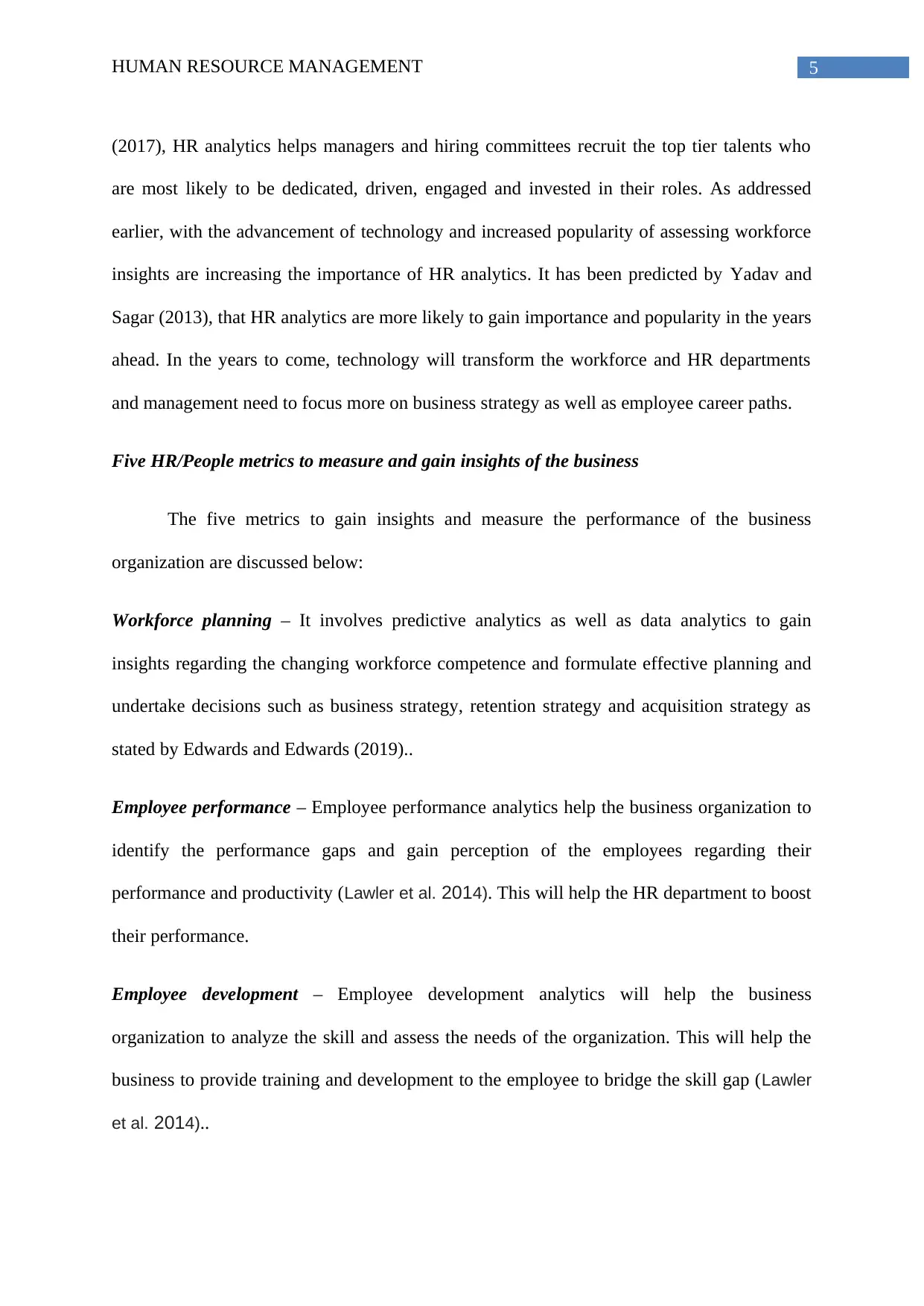
5HUMAN RESOURCE MANAGEMENT
(2017), HR analytics helps managers and hiring committees recruit the top tier talents who
are most likely to be dedicated, driven, engaged and invested in their roles. As addressed
earlier, with the advancement of technology and increased popularity of assessing workforce
insights are increasing the importance of HR analytics. It has been predicted by Yadav and
Sagar (2013), that HR analytics are more likely to gain importance and popularity in the years
ahead. In the years to come, technology will transform the workforce and HR departments
and management need to focus more on business strategy as well as employee career paths.
Five HR/People metrics to measure and gain insights of the business
The five metrics to gain insights and measure the performance of the business
organization are discussed below:
Workforce planning – It involves predictive analytics as well as data analytics to gain
insights regarding the changing workforce competence and formulate effective planning and
undertake decisions such as business strategy, retention strategy and acquisition strategy as
stated by Edwards and Edwards (2019)..
Employee performance – Employee performance analytics help the business organization to
identify the performance gaps and gain perception of the employees regarding their
performance and productivity (Lawler et al. 2014). This will help the HR department to boost
their performance.
Employee development – Employee development analytics will help the business
organization to analyze the skill and assess the needs of the organization. This will help the
business to provide training and development to the employee to bridge the skill gap (Lawler
et al. 2014)..
(2017), HR analytics helps managers and hiring committees recruit the top tier talents who
are most likely to be dedicated, driven, engaged and invested in their roles. As addressed
earlier, with the advancement of technology and increased popularity of assessing workforce
insights are increasing the importance of HR analytics. It has been predicted by Yadav and
Sagar (2013), that HR analytics are more likely to gain importance and popularity in the years
ahead. In the years to come, technology will transform the workforce and HR departments
and management need to focus more on business strategy as well as employee career paths.
Five HR/People metrics to measure and gain insights of the business
The five metrics to gain insights and measure the performance of the business
organization are discussed below:
Workforce planning – It involves predictive analytics as well as data analytics to gain
insights regarding the changing workforce competence and formulate effective planning and
undertake decisions such as business strategy, retention strategy and acquisition strategy as
stated by Edwards and Edwards (2019)..
Employee performance – Employee performance analytics help the business organization to
identify the performance gaps and gain perception of the employees regarding their
performance and productivity (Lawler et al. 2014). This will help the HR department to boost
their performance.
Employee development – Employee development analytics will help the business
organization to analyze the skill and assess the needs of the organization. This will help the
business to provide training and development to the employee to bridge the skill gap (Lawler
et al. 2014)..
⊘ This is a preview!⊘
Do you want full access?
Subscribe today to unlock all pages.

Trusted by 1+ million students worldwide
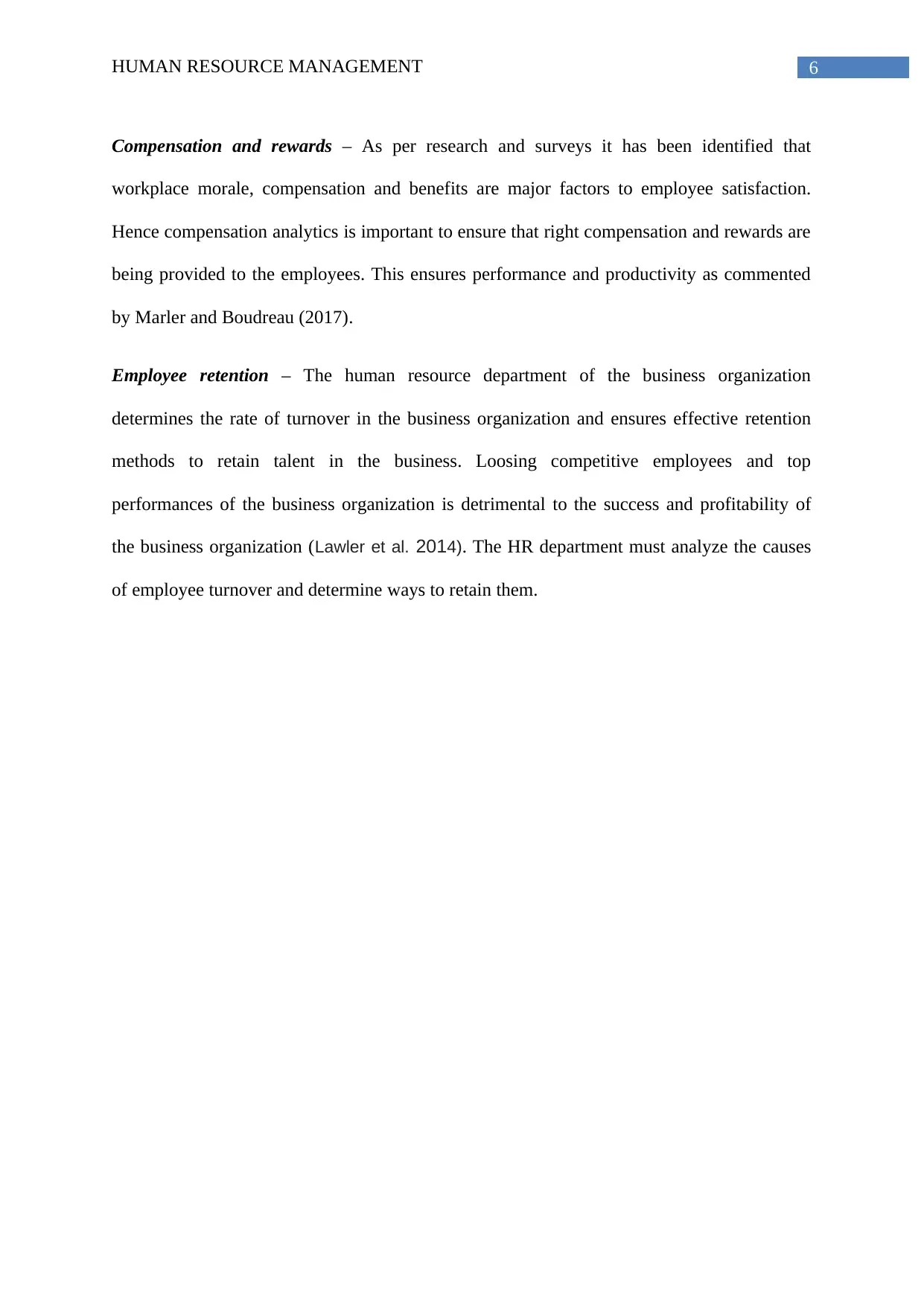
6HUMAN RESOURCE MANAGEMENT
Compensation and rewards – As per research and surveys it has been identified that
workplace morale, compensation and benefits are major factors to employee satisfaction.
Hence compensation analytics is important to ensure that right compensation and rewards are
being provided to the employees. This ensures performance and productivity as commented
by Marler and Boudreau (2017).
Employee retention – The human resource department of the business organization
determines the rate of turnover in the business organization and ensures effective retention
methods to retain talent in the business. Loosing competitive employees and top
performances of the business organization is detrimental to the success and profitability of
the business organization (Lawler et al. 2014). The HR department must analyze the causes
of employee turnover and determine ways to retain them.
Compensation and rewards – As per research and surveys it has been identified that
workplace morale, compensation and benefits are major factors to employee satisfaction.
Hence compensation analytics is important to ensure that right compensation and rewards are
being provided to the employees. This ensures performance and productivity as commented
by Marler and Boudreau (2017).
Employee retention – The human resource department of the business organization
determines the rate of turnover in the business organization and ensures effective retention
methods to retain talent in the business. Loosing competitive employees and top
performances of the business organization is detrimental to the success and profitability of
the business organization (Lawler et al. 2014). The HR department must analyze the causes
of employee turnover and determine ways to retain them.
Paraphrase This Document
Need a fresh take? Get an instant paraphrase of this document with our AI Paraphraser
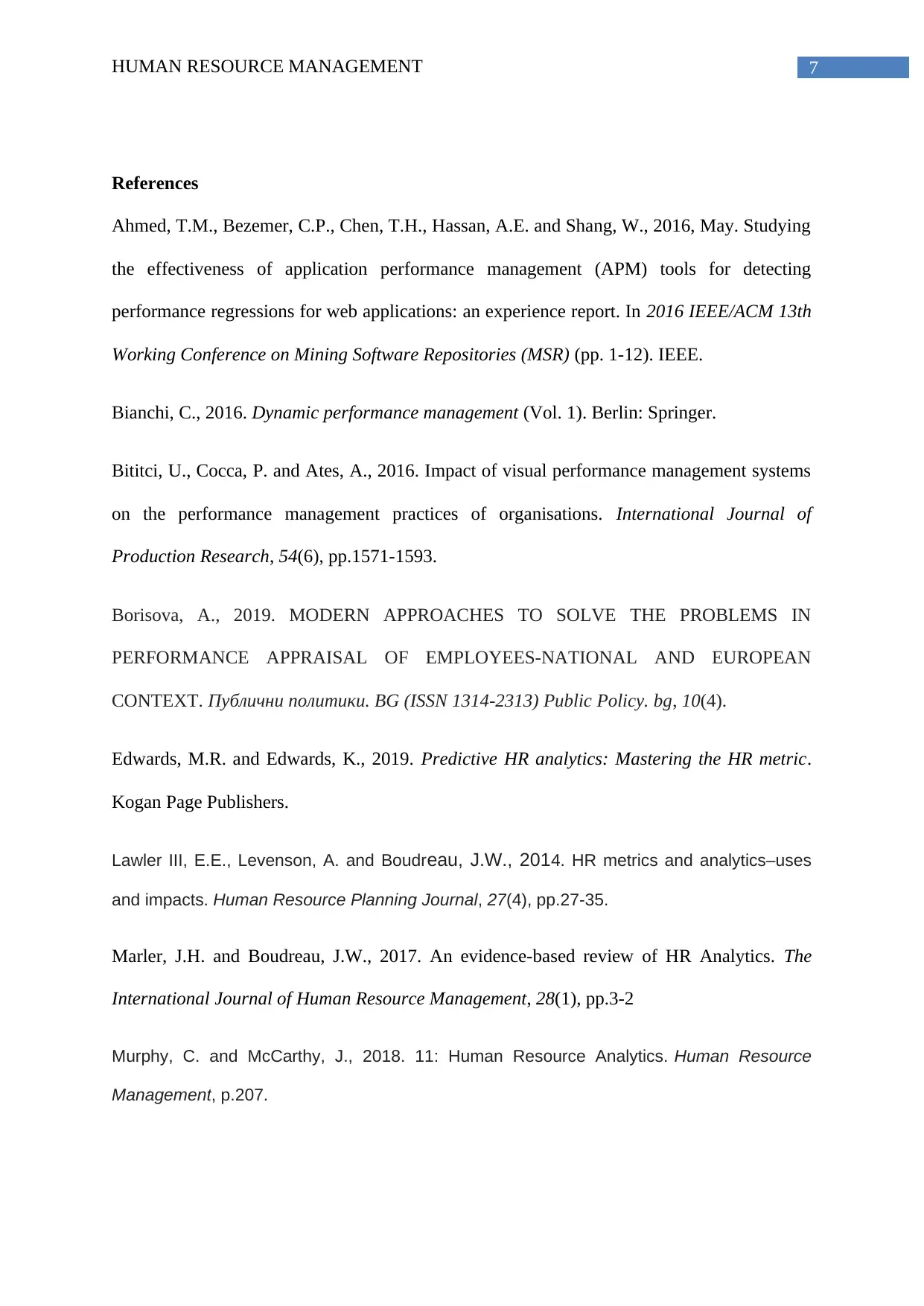
7HUMAN RESOURCE MANAGEMENT
References
Ahmed, T.M., Bezemer, C.P., Chen, T.H., Hassan, A.E. and Shang, W., 2016, May. Studying
the effectiveness of application performance management (APM) tools for detecting
performance regressions for web applications: an experience report. In 2016 IEEE/ACM 13th
Working Conference on Mining Software Repositories (MSR) (pp. 1-12). IEEE.
Bianchi, C., 2016. Dynamic performance management (Vol. 1). Berlin: Springer.
Bititci, U., Cocca, P. and Ates, A., 2016. Impact of visual performance management systems
on the performance management practices of organisations. International Journal of
Production Research, 54(6), pp.1571-1593.
Borisova, A., 2019. MODERN APPROACHES TO SOLVE THE PROBLEMS IN
PERFORMANCE APPRAISAL OF EMPLOYEES-NATIONAL AND EUROPEAN
CONTEXT. Публични политики. BG (ISSN 1314-2313) Public Policy. bg, 10(4).
Edwards, M.R. and Edwards, K., 2019. Predictive HR analytics: Mastering the HR metric.
Kogan Page Publishers.
Lawler III, E.E., Levenson, A. and Boudreau, J.W., 2014. HR metrics and analytics–uses
and impacts. Human Resource Planning Journal, 27(4), pp.27-35.
Marler, J.H. and Boudreau, J.W., 2017. An evidence-based review of HR Analytics. The
International Journal of Human Resource Management, 28(1), pp.3-2
Murphy, C. and McCarthy, J., 2018. 11: Human Resource Analytics. Human Resource
Management, p.207.
References
Ahmed, T.M., Bezemer, C.P., Chen, T.H., Hassan, A.E. and Shang, W., 2016, May. Studying
the effectiveness of application performance management (APM) tools for detecting
performance regressions for web applications: an experience report. In 2016 IEEE/ACM 13th
Working Conference on Mining Software Repositories (MSR) (pp. 1-12). IEEE.
Bianchi, C., 2016. Dynamic performance management (Vol. 1). Berlin: Springer.
Bititci, U., Cocca, P. and Ates, A., 2016. Impact of visual performance management systems
on the performance management practices of organisations. International Journal of
Production Research, 54(6), pp.1571-1593.
Borisova, A., 2019. MODERN APPROACHES TO SOLVE THE PROBLEMS IN
PERFORMANCE APPRAISAL OF EMPLOYEES-NATIONAL AND EUROPEAN
CONTEXT. Публични политики. BG (ISSN 1314-2313) Public Policy. bg, 10(4).
Edwards, M.R. and Edwards, K., 2019. Predictive HR analytics: Mastering the HR metric.
Kogan Page Publishers.
Lawler III, E.E., Levenson, A. and Boudreau, J.W., 2014. HR metrics and analytics–uses
and impacts. Human Resource Planning Journal, 27(4), pp.27-35.
Marler, J.H. and Boudreau, J.W., 2017. An evidence-based review of HR Analytics. The
International Journal of Human Resource Management, 28(1), pp.3-2
Murphy, C. and McCarthy, J., 2018. 11: Human Resource Analytics. Human Resource
Management, p.207.
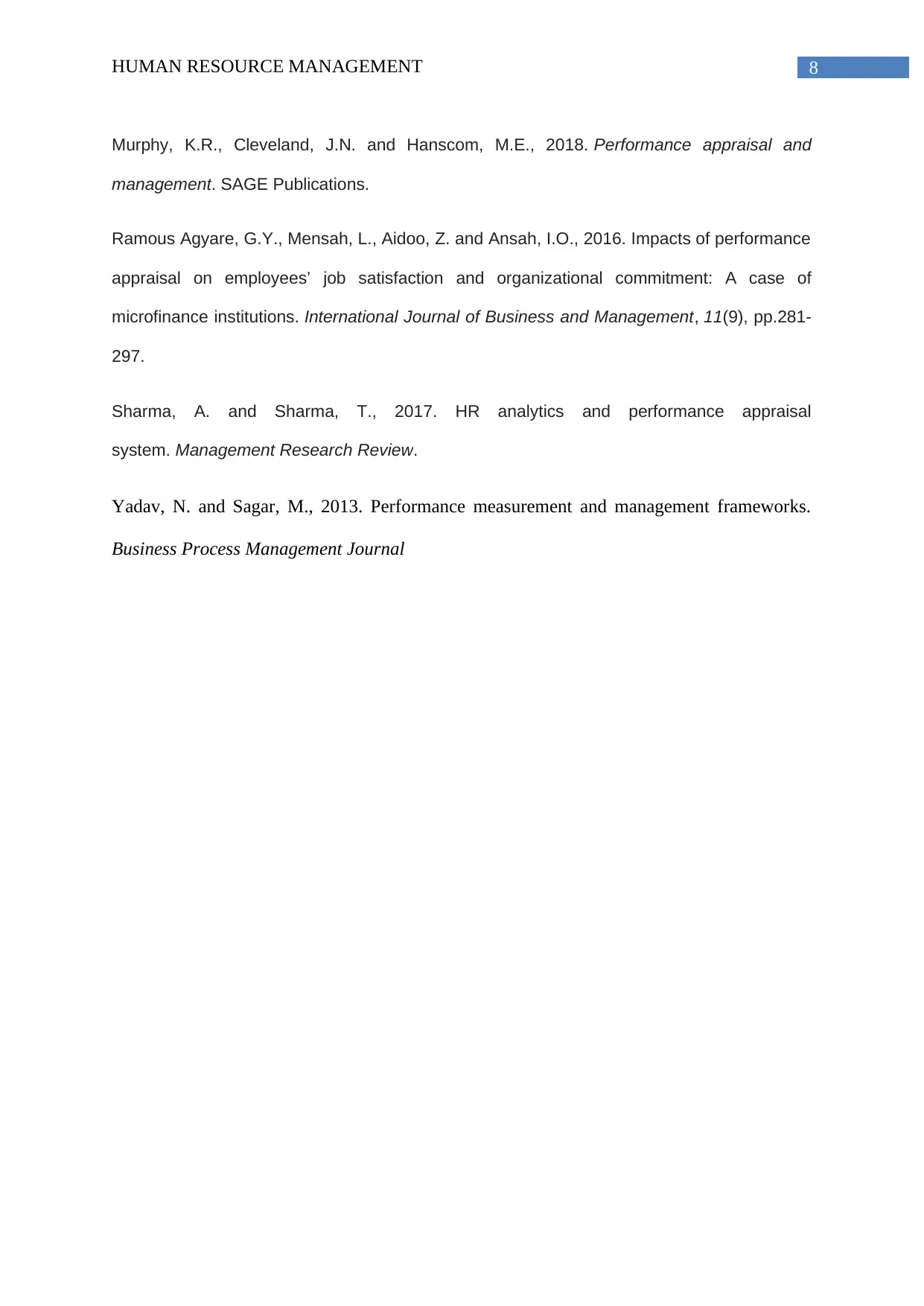
8HUMAN RESOURCE MANAGEMENT
Murphy, K.R., Cleveland, J.N. and Hanscom, M.E., 2018. Performance appraisal and
management. SAGE Publications.
Ramous Agyare, G.Y., Mensah, L., Aidoo, Z. and Ansah, I.O., 2016. Impacts of performance
appraisal on employees’ job satisfaction and organizational commitment: A case of
microfinance institutions. International Journal of Business and Management, 11(9), pp.281-
297.
Sharma, A. and Sharma, T., 2017. HR analytics and performance appraisal
system. Management Research Review.
Yadav, N. and Sagar, M., 2013. Performance measurement and management frameworks.
Business Process Management Journal
Murphy, K.R., Cleveland, J.N. and Hanscom, M.E., 2018. Performance appraisal and
management. SAGE Publications.
Ramous Agyare, G.Y., Mensah, L., Aidoo, Z. and Ansah, I.O., 2016. Impacts of performance
appraisal on employees’ job satisfaction and organizational commitment: A case of
microfinance institutions. International Journal of Business and Management, 11(9), pp.281-
297.
Sharma, A. and Sharma, T., 2017. HR analytics and performance appraisal
system. Management Research Review.
Yadav, N. and Sagar, M., 2013. Performance measurement and management frameworks.
Business Process Management Journal
⊘ This is a preview!⊘
Do you want full access?
Subscribe today to unlock all pages.

Trusted by 1+ million students worldwide
1 out of 9
Related Documents
Your All-in-One AI-Powered Toolkit for Academic Success.
+13062052269
info@desklib.com
Available 24*7 on WhatsApp / Email
![[object Object]](/_next/static/media/star-bottom.7253800d.svg)
Unlock your academic potential
Copyright © 2020–2025 A2Z Services. All Rights Reserved. Developed and managed by ZUCOL.





